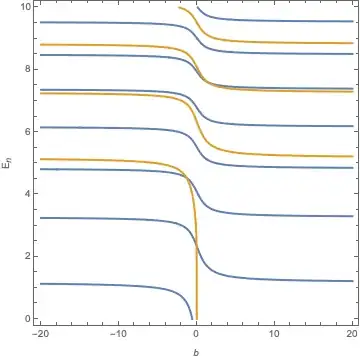I am currently trying to solve the problem of a particle confined within an infinite well subject to a linear electric field (i.e. triangular well). This entails solving the Schrodinger equation $$-\frac{\hbar^2}{2m}\partial^2_x\psi_n(x) + (V_l(x) +V_w(x)) \psi_n(x) = E_n \psi_n(x)$$ where $V_l(x) = q \varepsilon x $ (with $q$ and $\varepsilon$ being the elementary charge and amplitude of the electric field respectively) and $V_w(0>x>L) \to \infty$ (0 otherwise).
By defining the variable $z \equiv \left(\frac{2mq\varepsilon}{\hbar^2} \right)^{1/3}\left(x-\frac{E_n}{q\varepsilon} \right)$, the above Schrodinger equation (for $0<x<L$) becomes of the form
$$\partial_z^2\psi_n-z\psi_n=0.$$ The above has the general solution $\psi_n(z) = a Ai(z) + b Bi(z)$.
If the particle was not confined within a well (i.e. $V_w(x) = 0$ everywhere), one could set $b=0$ since $Bi(z)\to \infty$ as $z\to \infty$, and the wave function would not be normalizable otherwise. In this case, the energies $E_n$ can be easily found by solving for $Ai(z)=0$. After these are found, it is then easy to compute the normalization condition that would return an expression for $a$.
However, I am not sure that the argument $b=0$ can be made for the case in which the particle is indeed confined within an infinite well of finite length. This complicates the problem and I am not sure how I should proceed to find the energies $E_n$ and normalization constants $a$ and $b$. Can anyone help me with this?
